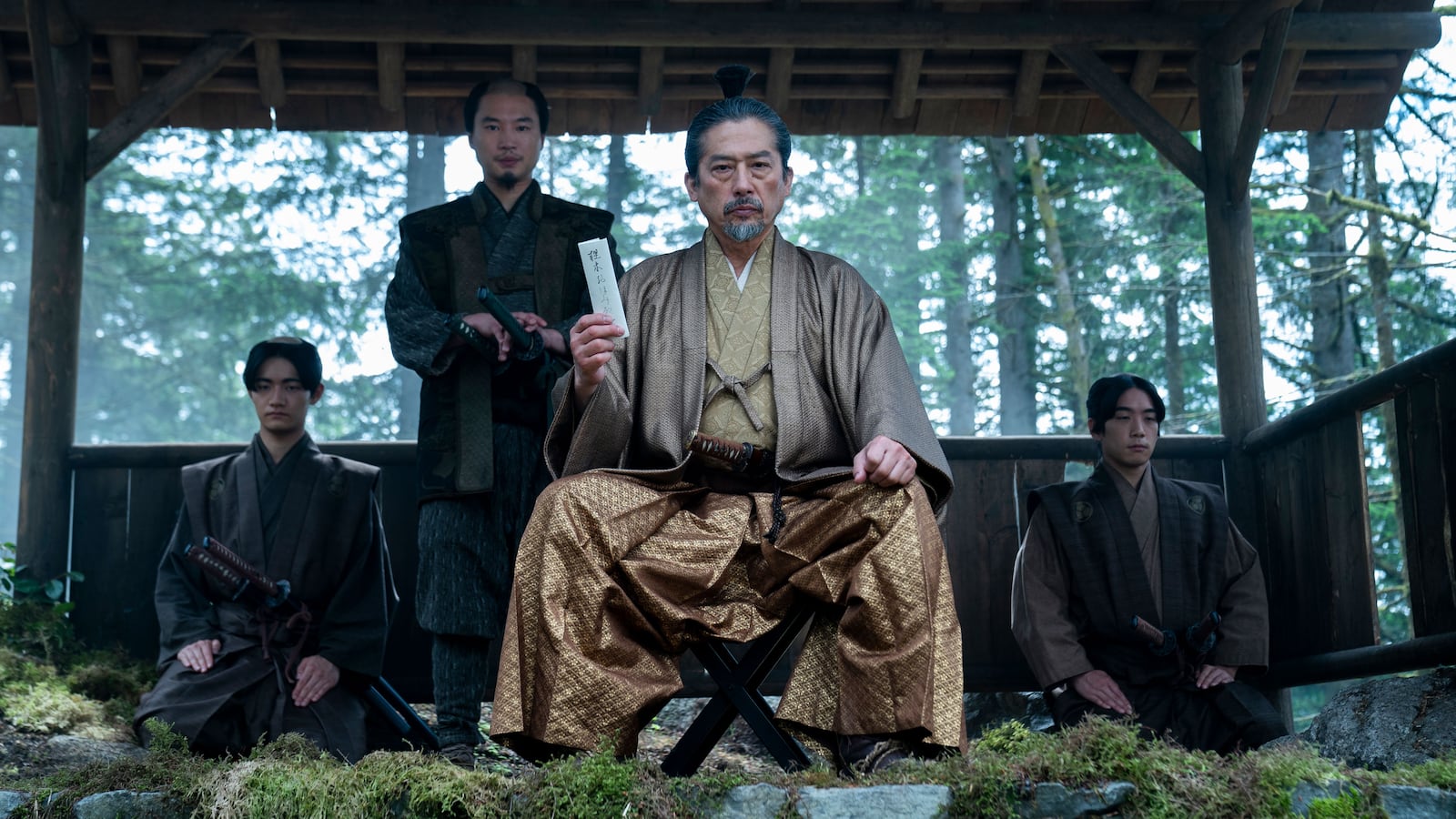Shōgun, whose 10-episode season ended Wednesday night on FX, is a remarkable adaptation of James Clavell’s 1975 novel. In a landscape of remakes, franchise, and reboots, it is a series that feels remarkably fresh, despite being the fourth time the book has been adapted (including an ill-fated, yet Tony-nominated, 1990 musical). Yet, in a story told almost exclusively in Japanese, perhaps the most remarkable thing about Shōgun is how it ends: not with a riotous, prestige television bang, but with a quiet and considered conclusion.
Over the course of its season, Shōgun’s action simmers under a calm exterior, erupting here and there in sudden bursts of energy. This isn’t a world of blood and gore, but one in which a conversation can be violence and death sudden and silent, as Lord Yoshii Toranaga (Hiroyuki Sanada) connives his way to becoming shōgun—the de facto military dictator of Japan. As its palace intrigue intensifies, Shōgun is gentle yet decisive in ratcheting up the tension around Toranaga’s grand plan.
It’s understandable, then, if viewers expect the release of that tension to be explosive. After all, so many characters reference that Toranaga is about to plunge Japan into war and even deep into the finale they talk about the battle to come. I admit, despite familiarity with the book, even I thought Shōgun would conclude with a battle—nor would I have blamed co-creators Rachel Kondo and Justin Marks for tossing one in.
To be fair, Shōgun does show a battle in the final episode, so maybe it does technically end with a big fight. It’s only a glimpse, however. Set within the 15-minute stretch in which Toranaga elucidates to his troublesome lieutenant Kashigi Yabushige (Tadanobu Asano) a future he’ll never see is a taste of the Battle of Sekigahara. It’s one of the most important moments in Japanese history, in which Toranaga’s real-world model, Tokugawa Ieyasu, defeated Ishida Mitsunari to pave his way to establishing the Tokugawa Shōgunate.
In Shōgun, we see thousands of CGI soldiers marching up a hill as the sun rises—and, given how they look, perhaps it’s best they weren’t employed in a lengthy battle—before Toranaga rides out, resplendent in golden armor, to meet a similarly decked out Lord Ishido (Takehiro Hira). We cut back to Yabushige, and Toranaga finally reveals his dream to shift power to Edo and bring forth an era of peace under the Toranaga Shōgunate.
That’s it.

Cosmo Jarvis as John Blackthorne and Moeka Hoshi as Usami Fuji.
Katie Yu/FXIt is at once a fitting and surprising move. Clavell’s novel ends in much the same way, with Yabushige’s death and the Battle of Sekigahara relegated to an awkward endpaper; it’s a smart move to shift this addendum into Toranaga’s vision of the future. But it’s also a smart move to cleave to the source material here and not rely on bombast and spectacle to close out a series that has hitherto been better without it. That’s not to say Shōgun isn’t a beautiful, epic in scope, and brutal series. Rather, Shōgun plays like a monumental game of chess, and like any game of chess, you don’t need to see the king fall to understand the game is over.
This is part of a stillness that haunts Shōgun, even in its most dramatic moments—a thoughtful, purposeful rhythm. A singular burst of anticlimactic energy at its end would only derail that rhythm. In particular, it would undermine the triumph of dramatic performance precipitated by Shōgun’s cast.
It’s fitting, then, that this scene is led by Sanada. It’s surprising, after 20 years of working in the West, that this is Hiroyuki Sanada’s first major leading role. Yet it’s impossible to imagine anyone else pulling off Toranaga’s quiet satisfaction in this moment, nor anyone being quite so charmingly baffled as Asano’s Yabushige as he realizes Toranaga is no different than the rest of us. It’s something Sanada carefully unfolds throughout the series, as he shifts from a champion of peace to someone ruthless, ambitious, even greedy, but always brilliant. Shōgun is Sanada’s series, and it’s only right that the most powerful scene in the finale is almost entirely his. Without him, it might have fallen flat.
That said, it’s easy to view this as Shōgun telling us what happens rather than showing us—to paraphrase an oft-misused tenet of storytelling—and to feel that the series’ ending may be all retch and no vomit in the end. But there is an important line early in the series that some may forget, come the finale; a near-direct quote from the book, when Toranaga says that a man has three hearts: “a false heart in his mouth for the world to see, another in his breast to show to his special friends and his family, and the real one, the true one, the secret one, which is never known to anyone except to himself alone.”
It might feel throwaway, but this is a statement of a thesis, an advertisement of the structure the whole series follows. As John Blackthorne (Cosmo Jarvis) finds his feet in Japan, we see the deflecting facade of a Toranaga interested only in peace, his family, and the security of his vassals. Later, when Blackthorne enters Toranaga’s service, we start to understand that Toranaga has pushed Japan to the brink of war, his ambition slowly manifesting. Yet, it is only in the final episode—and, let’s be frank, the title of the series—that the extent of Toranaga’s dream, his secret heart, is solidified.
The final conversation between Toranaga and Yabushige is a beautifully composed scene, the perfect cap to the journey through Toranaga’s hearts. It’s not a rebellion against “show don’t tell” so much as a deeply humanizing moment for Toranaga that might have been lost in the chaos of battle. After a series that has, at times, felt like a slow, deep breath before a plunge, this scene is one last exhalation as the future Toranaga envisions at last becomes fate—inexorable.

Cosmo Jarvis as John Blackthorne and Hiroyuki Sanada as Yoshii Toranaga.
Katie Yu/FXIt stands in contrast to what little remains. We see Usami (Moeka Hoshi) bury her son and husband before Blackthorne, with the help of Buntaro (Shinnosuke Abe), raises his ruined ship. They are beautiful visualizations of the grief Toranaga has left in his wake. But we know these people, dead and alive, are no more than pawns in his game. The real conclusion to the series is in those 15 minutes before Yabushige’s headless body tumbles from the cliff.
Shōgun’s ending might not be to everyone’s tastes, but then the series’ stillness might not be for everyone either. That this stillness remains in the finale, however, rather than giving way to a shattering explosion of unnecessary action is surprisingly bold and, in its own way, shocking. It’s an ending that defies the usual conventions of similar series, that surprises and delights. For a series like Shōgun, so far removed from what we’re both used to and tired of, I can’t think of anything more appropriate.






